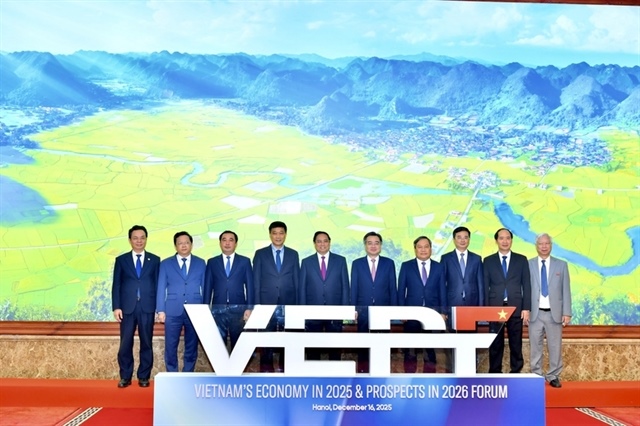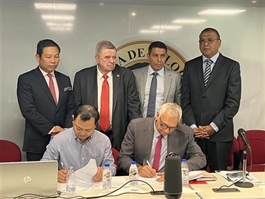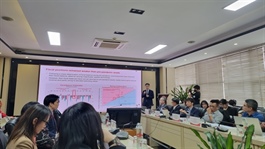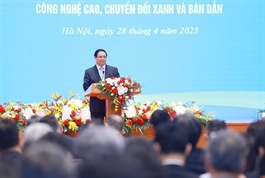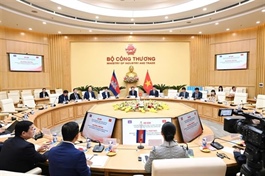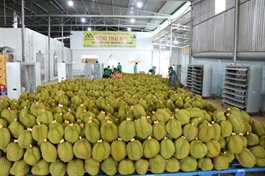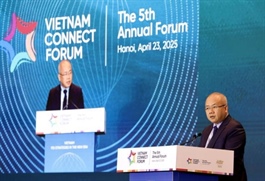The Singaporean role in Vietnam’s success
The Singaporean role in Vietnam’s success
Over the decades, Vietnam has shifted from a centrally planned economy to a socialist-oriented market economy, opening the country to international trade and investment. Tan Quee Peng, president of Singapore Chamber of Commerce Vietnam, spoke with VIR’s Bich Thuy about strengthening the bilateral partnership between the two nations.
What key factors have driven Vietnam’s impressive economic growth?

Tan Quee Peng, president of Singapore Chamber of Commerce Vietnam |
Vietnam’s political development over the last 50 years illustrates a carefully managed process. After reunification in 1975, the emphasis was on national consolidation and the establishment of socialist structures. Vietnam’s political reforms have been transformative, significantly reshaping the nation’s governance and socioeconomic landscape.
Vietnam has been riding out a series of economic storms since their reunification with demonstrated resilience and strength. From the Asian financial crisis in 1997 to the pandemic and global economic slowdown, the country has become the latest Southeast Asia’s success story in terms of resilience and development.
The reforms made since the 1980s have attracted significant foreign investment. Additionally, strategic integration into the global economy through trade agreements and membership in organisations like ASEAN and the World Trade Organization fuelled export-oriented manufacturing. These agreements have lowered tariffs and opened up in various new markets for Vietnamese goods.
Moreover, consistent government efforts in developing infrastructure have improved connectivity, facilitating economic activity, despite ongoing challenges. Significant investments in human and physical capital, particularly in education and infrastructure, have enhanced productivity and competitiveness.
The government’s focus on improving the business environment through more modern regulations have helped with advancing the business environment, and political stability has also helped to provide a relatively predictable environment for investment. In recent years, Vietnam has pursued bureaucratic restructuring, including the merging of ministries and streamlining of state agencies to improve efficiency and reduce corruption. This transformation has positioned Vietnam as a significant player in regional and global supply chains, making it one of the fastest-growing economies in the world, with a robust manufacturing sector and an emerging middle class.
What sci-tech advancements over the last 50 years have been crucial for Vietnam’s development?
In Vietnam, the telecommunications and IT revolution has been transformative. The widespread adoption of mobile phones and the internet has revolutionised communication, facilitated business operations, and expanded access to information and education.
Furthermore, advancements in healthcare technologies, including the development and application of vaccines and improved diagnostic tools, have led to significant improvements in public health outcomes and increased life expectancy.
In more recent decades, Vietnam has also focused on leveraging tech including AI, the Internet of Things, and big data, to enhance industrial productivity. The government has emphasised science, technology, and innovation as key drivers for the country’s future development, aiming for high-income status by 2045 with a significant contribution from the digital economy.
Vietnam’s policy framework identifies the aforementioned industries as pivotal to the country’s progress, aiming to ensure data security, enhance competitiveness, and guide Vietnam’s evolution in the digital age. A continued focus on these and emerging technologies will be crucial for Vietnam’s sustained progress.
These advancements have also improved productivity and competitiveness and positioned Vietnam as an emerging hub for technology and innovation in the region. The continued focus on sci-tech will be essential for sustaining Vietnam’s economic growth and achieving its goals.
How have Singapore and Vietnam enhanced exchanges to foster mutual understanding?
This has been carried out through several initiatives. Firstly, strengthening educational exchanges by encouraging student and faculty mobility between institutions in both countries can encourage cross-cultural learning and collaboration.
Joint cultural programmes, such as art exhibitions and music festivals, can also showcase the rich cultural heritage of both nations and create opportunities for people-to-people connections.
Additionally, encouraging tourism through collaborative marketing campaigns and cultural tourism packages can increase mutual awareness and appreciation of each other’s cultures. Sports exchanges and youth initiatives can also play a vital role in building friendships and understanding among the younger generations.
By leveraging these initiatives, Singapore and Vietnam can deepen their cultural ties, enhance mutual respect, and strengthen their bilateral relationship.
Furthermore, diplomatic efforts can play a significant role in enhancing cultural exchanges. High-level visits and cultural diplomacy, such as the exchange of traditional gifts and participation in cultural events, can symbolise the strong bond between the two countries.
By implementing these strategies, Singapore and Vietnam can create a robust framework for cultural exchanges that will contribute to a deeper mutual understanding and a stronger bilateral relationship in the coming years.
What do you envision for Vietnam’s role on the global stage in the next decade?
I envision Vietnam playing an increasingly significant and multifaceted role. Its sustained economic growth is likely to elevate its position as a key player in regional and global supply chains, particularly in manufacturing and potentially emerging technology sectors.
As a dynamic member of ASEAN, Vietnam will continue to contribute to regional stability and economic integration, potentially taking on greater leadership roles within the bloc.
Vietnam’s growing engagement in international trade agreements and its strategic geopolitical location will likely see it play a more active role in shaping regional and global dialogues on trade, security, and climate change. Its experience as a developing nation with a track record of economic success could also position it as a valuable voice in South-South cooperation and discussions on sustainable development.
While navigating complex geopolitical dynamics, Vietnam’s commitment to multilateralism and its growing economic and political influence suggest a trajectory towards a more prominent and influential role in the global landscape.
|
Chandan Singh, country managing director Hitachi Energy Vietnam Vietnam has been experiencing robust economic growth. To support its ambitious goals, electricity demand will need to increase by 1.5 times of GDP growth or even more, especially if we aim for carbon neutrality. This trend in electricity demand will undoubtedly lead to a significant rise in the demand for transformers. As electricity demand grows, the need for new transformers will proportionally increase. Over the past six months, Vietnam has achieved remarkable progress, particularly from a legislative standpoint. One of the most notable advancements is the revision of the Electricity Law. It includes provisions for renewable energy development, competitive electricity markets, and the integration of new energy sources. These changes are designed to enhance the law’s enforceability and effectiveness, ensuring that our electricity development policies are consistent with other relevant policies and the overall legal system. In addition to legislative reforms, the government is actively working to streamline its operations. By reducing the number of ministries and consolidating various agencies, we aim to create a more efficient and responsive government structure. This restructuring is expected to expedite decision-making processes and reduce bureaucratic hurdles, ultimately benefiting both businesses and citizens. From 2018 to 2021, the government implemented feed-in tariffs for solar and wind power projects, which boosted the sector. However, the government is now transitioning to a new framework. What I expect is that these new policies will be stable and forward-looking, minimising the risk of reversal even in the event of a change in government. Such stability is crucial for boosting business confidence and attracting sustained investment in Vietnam’s renewable energy sector. We have been operating in Vietnam since 1993. This year, we will inaugurate our new wet paint workshop and add more production lines to our high voltage factory. We believe in Vietnam’s growth story and its people. We will continue to carry out small-scale capital expenditure to strengthen our footprint while contributing to Vietnam’s energy transition. Ee-Hui Tan, managing director Vietnam and Cambodia, FedEx Vietnam’s strategic position is recognised as a growing hub for trade and commerce in Southeast Asia. We foresee a future where the logistics industry will increasingly leverage technology, sustainability, and innovation to enhance connectivity. Vietnam’s robust economic growth has been a significant driver for the logistics sector. As the economy expands, there is an increasing demand for efficient logistics services to support trade, e-commerce, and supply chain management. This growth has encouraged both domestic and foreign investments, leading to enhanced logistics infrastructure and capabilities. Recent reforms have played a crucial role in shaping a more conducive environment for logistics. One notable example is Vietnam’s participation in free trade deals that reduce barriers, resulting in rising trade volumes and activities. There are three key factors propelling the growth of Vietnam’s logistics sector, despite challenges in the global landscape. Firstly is strategic geographic location. Vietnam’s position as a gateway to Southeast Asia makes it an attractive hub for trade and logistics, enabling easy access to key markets. Our recent flight launch from Ho Chi Minh City to Asia, Middle East, Africa, and Europe with faster transit times can support our customers across all industries achieve cross-border success and facilitate the expansion of local businesses abroad, while also contributing to the advancement of Vietnam’s logistics landscape. The second aspect is technological advancement. The adoption of digital tools and technologies, such as AI, blockchain, automation, data analytics, and e-commerce platforms, is enhancing operational efficiency and responsiveness within the logistics sector. We’re transforming from a supply chain company to a supply chain technology company that makes supply chains smarter for everyone. We’re doing this by leveraging data and technology to run and transform our business, digitise our customers’ supply chains, and move up the e-commerce value chain. The final factor is growing domestic demand. Rising consumer demand, particularly in e-commerce, drives the need for efficient solutions to handle more volume. Dong Mai Lam, cluster president, Vietnam and Cambodia, Schneider Electric There are five global trends that are having a profound impact on every industry. In global rebalancing, there is uncertainty of the global political situation, complicated trade conflicts leading to a shift from globalisation to protectionism, an independent economy promoting localisation, and building dual supply chains, all reshaping the way businesses operate. In terms of the prosperity shift, a population explosion in India, Africa, and the Middle East, together with urbanisation, will create huge energy demand. By 2050, it is predicted that more than 1.3 billion people will live in these areas. This will lead to increased demand for housing, offices, and other utilities such as transportation, services, and energy. With climate change trends, the shift in prosperity brings many development opportunities but also many risks. Among them, the challenge of carbon emissions requires all constructions, factories, and energy-consuming activities to aim for green and sustainable criteria, capable of responding to climate change. There is now also an explosive trend of digitalisation and AI. To be competitive in the context of shifting supply chains and addressing climate change issues, we need to make fundamental changes. Digitalisation and the adoption of existing AI technologies will greatly help this transformation. We need to find innovative solutions to optimise processes, improve efficiency and promote sustainability. These solutions are supported by the megatrends of digitalisation and AI. However, this transition needs to be done sustainably, as the growth of more data centres will require more efficient cooling systems and the most efficient use of energy. In energy transition trends, with 80 per cent of carbon emissions coming from energy use and the global population expected to increase by two billion by 2050, the need for clean, sustainable energy sources is urgent. Current technologies can help eliminate 70 per cent of carbon emissions in the energy chain. |
- 08:00 01/05/2025



